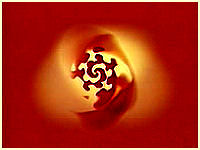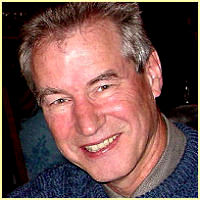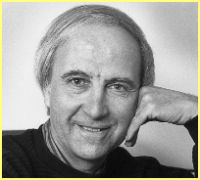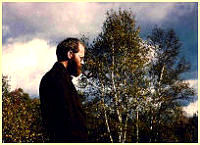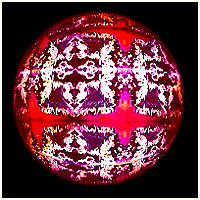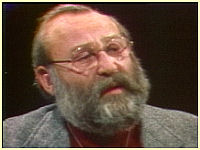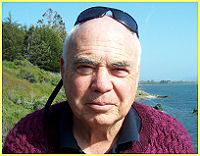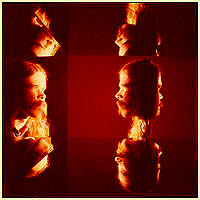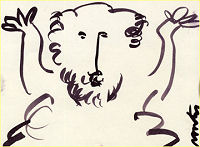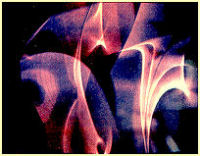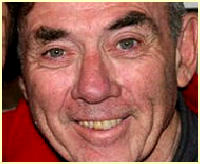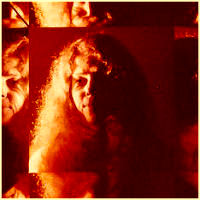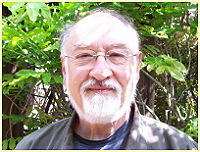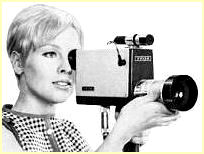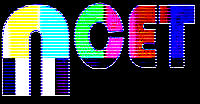
From here you can connect to all sections of the site.
This web site is dedicated to artists and the arts. Artistic 'visions' are essential; the benefits they bring to life, and to society, exceed calculation. The list at the left is comprised (alphabetically) of people who were both participant in the goings-on at NCET, and directly contributed to NCET's artistic output. (For a more complete listing, including participants in the 'experimental project,' see the Cast List page.) And below is a history of The National Center For Experiments in Television. Also, please note that we are solicitng contributions to the site (both text and grapics). We need your help to fill these (your) pages. Please contact Don Hallock directly (those of you who are NCET Alumni will have his email address), or use the Email Us link at the bottom of each page to access the catch-all mailbox (which is checked from time to time). Any content deemed suitable will be posted in the appropriate place on the site. WE NEED: In order to better help fill out this web site, please check the Things We Still Need page. On it you will find what's missing, including documents, pictures, anecdotes, etc. And please keep in mind that submitting material for posting automatically implies permission to have it published. NCET HISTORY: As with so many things, NCET began, not as itself, but as the KQED Experimental Project. In this first phase of its existence it was conceived and directed by Brice Howard, a former producer for the National Educational Television Network [NET] based in New York. The following section is excerpted from the larger article at the Experimental TV Center: The Videotape Collection at Media Study/Buffalo: written by John Minkowski, February 1978. Tapes from the National Center for Experiments in Television: The National Center for Experiments in Television in San Francisco, established in 1969 and active as a force in video experimentation until 1973 [actually 1975], grew out of experimental workshops held at public television station KQED in 1967. NCET, under the leadership of Brice Howard and Paul Kaufman, supported a group of artists from diverse backgrounds to cooperatively explore the electronic arts, as well as to design and develop new tools. In a facility separate from KQED, NCET artists were free from the constraints and pressures of producing work for broadcast, although works realized at NCET - such as Tom O'Horgan's experimental video/theater piece !Heimskringla! - were shown on public television. The Bay area...provided a home for a wide variety of video, but it... existed there in isolated pockets. People... worked nearby for years and [knew] nothing about each other's activities. The NCET is a prime example: it may have been a national center, but it was certainly never a local one. The work done there took the form of intense visual explorations in a narrow direction, so that the center existed like an island in the San Francisco art world, separate from most and unknown by many. ...For a variety of reasons, the early years of experimentation began to yield results in 1972-1973, when many interesting tapes were made. One characteristic shared by most of these tapes is a slowness of pace. The best tapes from this period at the center include Bill Gwin's and Warner Jepson's Irving Bridge, Willard Rosenquist's and Bill Roarty's Lostine, Don Hallock's Kiss With No Up, and Bill Roarty's and Don Hallock's Untitled. In all of these there is an across-the-board slowing down. A similar border area was explored by Bill Gwin and Warner Jepson in Irving Bridge. There is only one camera shot of a woods scene with a bridge. It begins "straight": you can recognize the scene and hear natural "woods" sounds. Very slowly both the visuals and the sound are altered electronically so that in the midst of the tape one is seeing an electronically colored equivalent of the woods and hearing electronic equivalents of bird sounds. Then just as slowly it changes back again. The tape was meant to be played on a loop so that the sonata-like three-part development of its structure would not be a pat thing; the scene would shift back and forth, from one kind of landscape to another. William Gwin, an artist at NCET during its most productive period, was commissioned by Media Study to select and transfer over 80 hours of tapes from the Center. Artists most comprehensively represented in the collection, through individual and collaborative works, are Bill Allen, Stephen Beck, Richard Felciano, William Gwin, Don Hallock, Brice Howard, Warner Jepson, William Roarty, Willard Rosenquist, Loren Sears, and Robert Zagone. Among the many completed works in the collection are Irving Bridge by Gwin and Jepson, Kiss With No Up by Hallock, Passage by Roarty, Lostine by Rosenquist, and Sorcery by Sears and Zagone. Highlights of process experiments and documents of the Center's activities include: six hours of Stephen Beck's work (1970-74) including the first recorded images produced with his Direct Video Synthesizer and digital Video Weaver; more than 10 hours of "Videospace Electronic Notebooks" and "Notes in the Beginning," which are theoretical discussions/demonstrations concerned with video's unique properties; and many experiments integrating video with the other temporal arts of dance, theater, music, and poetry, including video processing of readings by Charles Olson and Robert Creeley. Complete article - on line... The following is excerpted from the article: National Center for Experiments in Television at KQED-TV, 1967 - 1975, San Francisco, CA, by Steve Seid, Video Curator of the Pacific Film Archives and Maria Troy, Associate Curator of the Wexner Center, June 17, 2000, describing NCET at KQED. it is posted at the Experimental TV Center web site. The NCET was an artists’ research facility tenuously aligned with San Francisco’s public station, KQED. The videoworks to be presented at PFA cover the primary thrusts of the Center, cross- disciplinary performance-oriented video, and image processing, and span the Center’s lifetime--1967 to 1975. Pacific Film Archive is going to make these pioneering works available as a group of assembled compilations, beginning in the late fall of this year. [2000] The National Center for Experiments in Television was the first of the so-called TV labs. In its earliest conception, the NCET was really the Experimental TV Project, housed at KQED and funded by the National Endowment for the Arts and the Rockefeller Foundation. This was 1967. The driving theory behind the Experimental TV Project was to provide equipment access (an absolute rarity in those days) to a cross - disciplinary group of artists who would explore new modes of expression, simultaneously developing alternative visual languages. Under the guidance of director Brice Howard, a groundbreaking body of works was completed that redirected video technology toward unconventional experimentation. Works such as William Stewart Jones’ Graham Tape Delay, Richard Felciano’s Linearity and Joanne Kyger’s Descartes exemplified the preoccupation with performative disciplines and image processing. This culminated in the 90-minute production of ¡Heimskringla!, a videoplay combining the talents of the La Mama Theater, director Tom O’Horgan, and the NCET crew. In 1969, the Experimental TV Project was renamed the National Center for Experiments in Television, and funded by the Rockefeller Foundation and the Corporation for Public Broadcasting. A new group of resident artists was brought in which included Stephen Beck, Willard Rosenquist, Warner Jepson, William Gwin, Don Hallock and William Roarty. Works such as Beck’s Cosmic Portal, Rosenquist’s Light Forms, Hallock’s TheFather Tapes and Roarty’s Untitled were completed during this period. The need to expand the image processing possibilities in the NCET studio was solved by the designation of two “circuit engineers,” Stephen Beck who built his Direct Video Synthesizer, and Lawrence Templeton who built the “mix” station [Templeton video Mixer]. Another principal concern of the NCET is seen in the Videospace Electronic Notebooks, a series of vaguely didactic programs that contextualized the Center’s philosophy of experimentation. "A medium is available. A very sophisticated, complex technology which human beings invested is available to us. It is dumb, inarticulate, contains no magic. It is available and manageable and probably stunningly beautiful when managed by graceful people who are bent on acts of expression ... This newer medium is swift in nature. It demands a new kind of perception. It moves like light sparked into life as through a nervous prism. It is another paint, another dance, another music of sound. Another message meant to catch the quick vision of the inner eye."The National Center for Experiments in Television’s greatest asset was probably also cause for its demise - the mandate to innovate without end, nor end-product. Unlike other TV labs where the culmination of a residency might lead to programming, the NCET residents had no specific prerequisite. This led to an estrangement with KQED in which the Center abandoned the station and its studio facilities, concentrating now on smaller format technologies. The works from the later period tend to be more painterly and time-based as their video synthesis, feedback, and keying resources expanded. Dating from 1967 to 1975, the videoworks from the NCET offer an unusual glimpse of some of the earliest efforts to turn television technologies toward other ends. Often this end meant the simple joy of an electronic surface that evolved as so many discrete paintings; at other times, this meant rendering other art forms-poetry, dance, music, painting - as recombinant expressions within what Brice Howard called “videospace.” These tapes also allow us to observe not just the creative output of individuals, but the concerted labors of an institution to rally and promote a new form of television.
|
 Web site by See Lion Productions
Web site by See Lion ProductionsWeb Composition: Don Hallock
Advice and support: Rick Davis
With Major contributions by John Minkowsky - author of a forthcoming book on the important role played by three public television stations – KQED in San Francisco, WGBH in Boston, and WNET in New York – in the development of video art.
Home | Cast List | Email Us | Site Map
